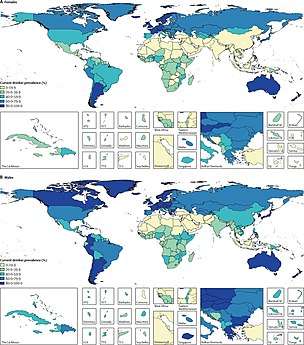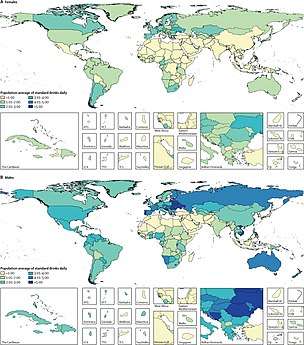Alcoholic drink
An alcoholic drink (or alcoholic beverage) is a drink that contains the recreational drug ethanol, a type of alcohol produced by fermentation of grains, fruits, or other sources of sugar. The consumption of alcohol plays an important social role in many cultures. Most countries have laws regulating the production, sale, and consumption of alcoholic beverages.[2] Some countries ban such activities entirely, but alcoholic drinks are legal in most parts of the world. The global alcoholic drink industry exceeded $1 trillion in 2018.[1]

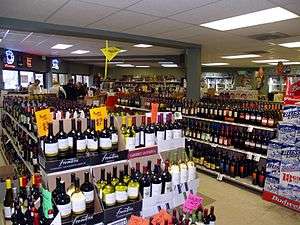
Alcohol is a depressant, which in low doses causes euphoria, reduces anxiety, and improves sociability. In higher doses, it causes drunkenness, stupor, unconsciousness, or death. Long-term use can lead to alcohol abuse, cancer, physical dependence, and alcoholism. Alcohol is one of the most widely used recreational drugs in the world, with about 33% of people being current drinkers.[3] As of 2016, women on average drink 0.7 drinks and males 1.7 drinks a day.[3] In 2015, among Americans, 86% of adults had consumed alcohol at some point, 70% had drunk it in the last year, and 56% in the last month.[4] Alcoholic drinks are typically divided into three classes—beers, wines, and spirits—and typically their alcohol content is between 3% and 50%.
Discovery of late Stone Age jugs suggest that intentionally fermented drinks existed at least as early as the Neolithic period (cir. 10,000 BC).[5] Many animals also consume alcohol when given the opportunity and are affected in much the same way as humans, although humans are the only species known to produce alcoholic drinks intentionally.[6]
Fermented drinks
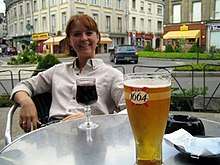
Beer
Beer is a beverage fermented from grain mash. It is typically made from barley or a blend of several grains and flavored with hops. Most beer is naturally carbonated as part of the fermentation process. If the fermented mash is distilled, then the drink becomes a spirit. In the Andean region, the most common beer is chicha, made from grain or fruits.[7] Beer is the most consumed alcoholic beverage in the world.[8]
Wine
Wine is a fermented beverage produced from grapes and sometimes other fruits. Wine involves a longer fermentation process than beer and a long aging process (months or years), resulting in an alcohol content of 9%–16% ABV.
Cider
Cider or cyder (/ˈsaɪdər/ SY-dər) is a fermented alcoholic drink made from any fruit juice; apple juice (traditional and most common), peaches, pears ("Perry" cider) or other fruit. Cider alcohol content varies from 1.2% ABV to 8.5% or more in traditional English ciders. In some regions, cider may be called "apple wine".[9]
Fermented tea
Fermented tea (also known as post-fermented tea or dark tea) is a class of tea that has undergone microbial fermentation, from several months to many years. The tea leaves and the liquor made from them become darker with oxidation. Thus, the various kinds of fermented teas produced across China are also referred to as dark tea, not be confused with black tea. The most famous fermented tea is kombucha which is often homebrewed, pu-erh, produced in Yunnan Province,[10][11] and the Anhua dark tea produced in Anhua County of Hunan Province. The majority of kombucha on the market are under 0.5% ABV.
Mead
Mead (/miːd/) is an alcoholic drink made by fermenting honey with water, sometimes with various fruits, spices, grains, or hops. The alcoholic content of mead may range from about 8% ABV to more than 20%. The defining characteristic of mead is that the majority of the drink's fermentable sugar is derived from honey.
Pulque
Pulque is the Mesoamerican fermented drink made from the "honey water" of maguey, Agave americana. The drink distilled from pulque is tequila or mescal Mezcal.[12]
Others
"Fruit wines" are made from fruits other than grapes, such as plums, cherries, or apples.
Sparkling wine like French Champagne, Catalan Cava or Italian Prosecco can be made by means of a secondary fermentation.
Distilled drinks
A distilled drink or liquor is an alcoholic drink produced by distilling (i.e., concentrating by distillation) ethanol produced by means of fermenting grain, fruit, or vegetables.[13] Unsweetened, distilled, alcoholic drinks that have an alcohol content of at least 20% ABV are called spirits.[14] For the most common distilled drinks, such as whiskey and vodka, the alcohol content is around 40%. The term hard liquor is used in North America to distinguish distilled drinks from undistilled ones (implicitly weaker). Vodka, gin, baijiu, tequila, whiskey, brandy, rum, and soju are examples of distilled drinks. Distilling concentrates the alcohol and eliminates some of the congeners. Freeze distillation concentrates ethanol along with methanol and fusel alcohols (fermentation by-products partially removed by distillation) in applejack.
Fortified wine is wine, such as port or sherry, to which a distilled beverage (usually brandy) has been added.[15] Fortified wine is distinguished from spirits made from wine in that spirits are produced by means of distillation, while fortified wine is simply wine that has had a spirit added to it. Many different styles of fortified wine have been developed, including port, sherry, madeira, marsala, commandaria, and the aromatized wine vermouth.[16]
Rectified spirit
Rectified spirit, also called "neutral grain spirit", is alcohol which has been purified by means of "rectification" (i.e. repeated distillation). The term neutral refers to the spirit's lack of the flavor that would have been present if the mash ingredients had been distilled to a lower level of alcoholic purity. Rectified spirit also lacks any flavoring added to it after distillation (as is done, for example, with gin). Other kinds of spirits, such as whiskey, are distilled to a lower alcohol percentage to preserve the flavor of the mash.
Rectified spirit is a clear, colorless, flammable liquid that may contain as much as 95% ABV. It is often used for medicinal purposes. It may be a grain spirit or it may be made from other plants. It is used in mixed drinks, liqueurs, and tinctures, and also as a household solvent.
Congeners
In the alcoholic drinks industry, congeners are substances produced during fermentation. These substances include small amounts of chemicals such as occasionally desired other alcohols, like propanol and 3-methyl-1-butanol, but also compounds that are never desired such as acetone, acetaldehyde and glycols. Congeners are responsible for most of the taste and aroma of distilled alcoholic drinks, and contribute to the taste of non-distilled drinks.[17] It has been suggested that these substances contribute to the symptoms of a hangover.[18] Tannins are congeners found in wine in the presence of phenolic compounds. Wine tannins add bitterness, have a drying sensation, taste herbaceous and are often described as astringent. Wine tannins adds balance, complexity, structure and makes a wine last longer, so they play an important role in the aging of wine.[19]
Food energy
Alcoholic drinks are a source of food energy. The USDA uses a figure of 6.93 kilocalories (29.0 kJ) per gram of alcohol (5.47 kcal or 22.9 kJ per ml) for calculating food energy.[20] In addition to alcohol, many alcoholic drinks contain carbohydrates. For example, in 12 US fl oz (355 ml) of 5% ABV beer, along with approximately 18 ml of alcohol (96 kilocalories or 400 kilojoules), there are usually 10–15 g of carbohydrates (about 40–60 kcal or 170–250 kJ). Excessive daily calorie intake may contribute to an increase in body weight and "beer belly". In addition to the direct effect of its caloric content, alcohol is also known to potentiate the insulin response of the human body to glucose, which, in essence, "instructs" the body to convert consumed carbohydrates into fat and to suppress carbohydrate and fat oxidation.[21][22] Ethanol is directly processed in the liver to acetyl CoA, the same intermediate product as in glucose metabolism. Because ethanol is mostly metabolized and consumed by the liver, chronic excessive use can lead to fatty liver. This leads to a chronic inflammation of the liver and eventually alcoholic liver disease.
Amount of use
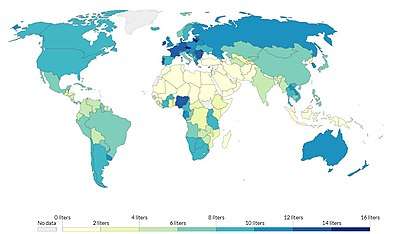
The average number of people who drink as of 2016 was 39% for males and 25% for females (2.4 billion people in total).[3] Females on average drink 0.7 drinks per day while males drink 1.7 drinks per day.[3] The rates of drinking varies significantly in different areas of the world.[3]
Reasons for use
Apéritifs and digestifs
An apéritif is any alcoholic beverage usually served before a meal to stimulate the appetite,[24] while a digestif is any alcoholic beverage served after a meal for the stated purpose of improving digestion. Fortified wine, liqueurs, and dry champagne are common apéritifs. Because apéritifs are served before dining, they are usually dry rather than sweet. One example is Cinzano, a brand of vermouth. Digestifs include brandy, fortified wines and herb-infused spirits (Drambuie).
Flavoring
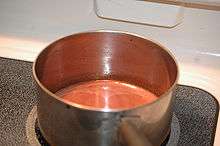
Pure ethanol tastes bitter to humans; some people also describe it as sweet.[25] However, ethanol is also a moderately good solvent for many fatty substances and essential oils. This facilitates the use of flavoring and coloring compounds in alcoholic drinks as a taste mask, especially in distilled drinks. Some flavors may be naturally present in the beverage's raw material. Beer and wine may also be flavored before fermentation, and spirits may be flavored before, during, or after distillation. Sometimes flavor is obtained by allowing the beverage to stand for months or years in oak barrels, usually made of American or French oak. A few brands of spirits may also have fruit or herbs inserted into the bottle at the time of bottling.
Wine is important in cuisine not just for its value as an accompanying beverage, but as a flavor agent, primarily in stocks and braising, since its acidity lends balance to rich savory or sweet dishes.[26] Wine sauce is an example of a culinary sauce that uses wine as a primary ingredient.[27] Natural wines may exhibit a broad range of alcohol content, from below 9% to above 16% ABV, with most wines being in the 12.5–14.5% range.[28] Fortified wines (usually with brandy) may contain 20% alcohol or more.
Alcohol measurement
Alcohol concentration
| Beers | typically 5% (range is from 3–15%) |
| Wines | typically 13.5% (range is from 8%–17%) |
| Fortified wines | 15–22% |
| Spirits | typically 30%-40% (range is from 15% to, in some rare cases, up to 98%) |
| Fruit juices | < 0.1% |
| Cider, wine coolers | 4%–8% |
The concentration of alcohol in a beverage is usually stated as the percentage of alcohol by volume (ABV, the number of milliliters (ml) of pure ethanol in 100 ml of beverage) or as proof. In the United States, proof is twice the percentage of alcohol by volume at 60 degrees Fahrenheit (e.g. 80 proof = 40% ABV). Degrees proof were formerly used in the United Kingdom, where 100 degrees proof was equivalent to 57.1% ABV. Historically, this was the most dilute spirit that would sustain the combustion of gunpowder.
Ordinary distillation cannot produce alcohol of more than 95.6% by weight, which is about 97.2% ABV (194.4 proof) because at that point alcohol is an azeotrope with water. A spirit which contains a very high level of alcohol and does not contain any added flavoring is commonly called a neutral spirit. Generally, any distilled alcoholic beverage of 170 US proof or higher is considered to be a neutral spirit.[30]
Most yeasts cannot reproduce when the concentration of alcohol is higher than about 18%, so that is the practical limit for the strength of fermented drinks such as wine, beer, and sake. However, some strains of yeast have been developed that can reproduce in solutions of up to 25% ABV.[31]
Serving measures
Shot sizes
Shot sizes vary significantly from country to country. In the United Kingdom, serving size in licensed premises is regulated under the Weights and Measures Act (1985). A single serving size of spirits (gin, whisky, rum, and vodka) are sold in 25 ml or 35 ml quantities or multiples thereof.[32] Beer is typically served in pints (568 ml), but is also served in half-pints or third-pints. In Israel, a single serving size of spirits is about twice as much, 50 or 60 mL.
The shape of a glass can have a significant effect on how much one pours. A Cornell University study of students and bartenders' pouring showed both groups pour more into short, wide glasses than into tall, slender glasses.[33] Aiming to pour one shot of alcohol (1.5 ounces or 44.3 ml), students on average poured 45.5 ml & 59.6 ml (30% more) respectively into the tall and short glasses. The bartenders scored similarly, on average pouring 20.5% more into the short glasses. More experienced bartenders were more accurate, pouring 10.3% less alcohol than less experienced bartenders. Practice reduced the tendency of both groups to over pour for tall, slender glasses but not for short, wide glasses. These misperceptions are attributed to two perceptual biases: (1) Estimating that tall, slender glasses have more volume than shorter, wider glasses; and (2) Over focusing on the height of the liquid and disregarding the width.
Standard drinks
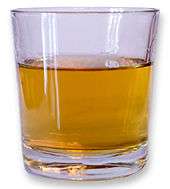
A standard drink is a notional drink that contains a specified amount of pure alcohol. The standard drink is used in many countries to quantify alcohol intake. It is usually expressed as a measure of beer, wine, or spirits. One standard drink always contains the same amount of alcohol regardless of serving size or the type of alcoholic beverage. The standard drink varies significantly from country to country. For example, it is 7.62 ml (6 grams) of alcohol in Austria, but in Japan it is 25 ml (19.75 grams).
- In the United Kingdom, there is a system of units of alcohol which serves as a guideline for alcohol consumption. A single unit of alcohol is defined as 10 ml. The number of units present in a typical drink is sometimes printed on bottles. The system is intended as an aid to people who are regulating the amount of alcohol they drink; it is not used to determine serving sizes.
- In the United States, the standard drink contains 0.6 US fluid ounces (18 ml) of alcohol. This is approximately the amount of alcohol in a 12-US-fluid-ounce (350 ml) glass of beer, a 5-US-fluid-ounce (150 ml) glass of wine, or a 1.5-US-fluid-ounce (44 ml) glass of a 40% ABV (80 US proof) spirit.
Laws
Alcohol laws regulate the manufacture, packaging, labelling, distribution, sale, consumption, blood alcohol content of motor vehicle drivers, open containers, and transportation of alcoholic drinks. Such laws generally seek to reduce the adverse health and social impacts of alcohol consumption. In particular, alcohol laws set the legal drinking age, which usually varies between 16 and 25 years, sometimes depending upon the type of drink (e.g., beer vs. hard liquor). Some countries do not have a legal drinking or purchasing age, but most countries set the minimum age at 18 years.[2] Such laws may take the form of permitting distribution only to licensed stores, monopoly stores, or pubs and they are often combined with taxation, which serves to reduce the demand for alcohol (by raising its price) and it is a form of revenue for governments. These laws also often limit the hours or days (e.g., "blue laws") on which alcohol may be sold or served, as can also be seen in the "last call" ritual in US and Canadian bars, where bartenders and servers ask patrons to place their last orders for alcohol, due to serving hour cutoff laws. In some countries, alcohol cannot be sold to a person who is already intoxicated. Alcohol laws in many countries prohibit drunk driving.
In some jurisdictions, alcoholic drinks are totally prohibited for reasons of religion (e.g., Islamic countries with sharia law) or for reasons of local option, public health, and morals (e.g., Prohibition in the United States from 1920 to 1933). In jurisdictions which enforce sharia law, the consumption of alcoholic drinks is an illegal offense,[34] although such laws may exempt non-Muslims.[35]
History
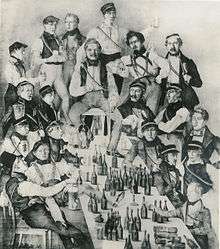
- 10,000–5,000 BC: Discovery of late Stone Age jugs suggests that intentionally fermented drinks existed at least as early as the Neolithic period.[36]
- 7000–5600 BC: Examination and analysis of ancient pottery jars from the neolithic village of Jiahu in the Henan province of northern China revealed residue left behind by the alcoholic drinks they had once contained. According to a study published in the Proceedings of the National Academy of Sciences, chemical analysis of the residue confirmed that a fermented drink made of grape and hawthorn fruit wine, honey mead and rice beer was being produced in 7000–5600 BC (McGovern et al., 2005; McGovern 2009).[37][38] The results of this analysis were published in December 2004.[39]
- 9th century AD: The medieval Arabs used the distillation process extensively, and applied it to the distillation of alcohol. The Arab chemist Al-Kindi unambiguously described the distillation of wine in the 9th century.[40][41][42]
- 12th century: The process of distillation spread from the Middle East to Italy,[40][43] where distilled alcoholic drinks were recorded in the mid-12th century.[44] In China, archaeological evidence indicates that the true distillation of alcohol began during the 12th century Jin or Southern Song dynasties.[45] A still has been found at an archaeological site in Qinglong, Hebei, dating to the 12th century.[45]
- 14th century: In India, the true distillation of alcohol was introduced from the Middle East, and was in wide use in the Delhi Sultanate by the 14th century.[43] By the early 14th century, distilled alcoholic drinks had spread throughout the European continent.[44]
See also
- Beer and breweries by region
- Chinese alcoholic beverages
- Cooking with alcohol
- Homebrewing
- List of alcoholic drinks
- List of countries by alcohol consumption
- List of national drinks
- Mixed drink
- Liquor
References
- "Worldwide Alcohol Consumption Declines -1.6%". International Wines and Spirits Record (ISWR). 2019-05-30. Retrieved 2019-06-04.
- "Minimum Legal Age Limits". IARD.org. International Alliance for Responsible Drinking. Retrieved 23 June 2016.
- Griswold, Max G.; Fullman, Nancy; Hawley, Caitlin; Arian, Nicholas; Zimsen, Stephanie R M.; Tymeson, Hayley D.; Venkateswaran, Vidhya; Tapp, Austin Douglas; Forouzanfar, Mohammad H.; Salama, Joseph S.; Abate, Kalkidan Hassen; Abate, Degu; Abay, Solomon M.; Abbafati, Cristiana; Abdulkader, Rizwan Suliankatchi; Abebe, Zegeye; Aboyans, Victor; Abrar, Mohammed Mehdi; Acharya, Pawan; Adetokunboh, Olatunji O.; Adhikari, Tara Ballav; Adsuar, Jose C.; Afarideh, Mohsen; Agardh, Emilie Elisabet; Agarwal, Gina; Aghayan, Sargis Aghasi; Agrawal, Sutapa; Ahmed, Muktar Beshir; Akibu, Mohammed; et al. (August 2018). "Alcohol use and burden for 195 countries and territories, 1990–2016: a systematic analysis for the Global Burden of Disease Study 2016". The Lancet. 392 (10152): 1015–35. doi:10.1016/S0140-6736(18)31310-2. PMC 6148333. PMID 30146330.
- "Alcohol Facts and Statistics". National Institute on Alcohol Abuse and Alcoholism. National Institute of Health. August 2018. Retrieved 8 October 2018.
- Charles H, Patrick; Durham, NC (1952). Alcohol, Culture, and Society. Duke University Press (reprint edition by AMS Press, New York, 1970). pp. 26–27. ISBN 978-0-404-04906-5.
- Zielinski, Sarah (16 September 2011). "The Alcoholics of the Animal World". Smithsonian.
- John C. Super, "Alcoholic Beverages" in Encyclopedia of Latin American History and Culture, vol. 1, p. 45. New York: Charles Scribner's Sons 1996.
- Nelson, Max (2005). The Barbarian's Beverage: A History of Beer in Ancient Europe. Abingdon, Oxon: Routledge. p. 1. ISBN 978-0-415-31121-2. Retrieved 21 September 2010.
- Martin Dworkin, Stanley Falkow (2006). The Prokaryotes: Proteobacteria: alpha and beta subclasses. Springer. p. 169. ISBN 978-0-387-25495-1. Retrieved 29 July 2011.
- Mo, Haizhen, Yang Zhu, and Zongmao Chen. "Microbial fermented tea–a potential source of natural food preservatives." Trends in food science & technology 19.3 (2008): 124-130.
- Lv, Hai-peng, et al. "Processing and chemical constituents of Pu-erh tea: A review." Food Research International 53.2 (2013): 608-618.
- Super, "Alcoholic Beverages", pp. 45–46.
- "Distilled spirit/distilled liquor". Britannica.com. Retrieved 2013-02-05.
- Lichine, Alexis. Alexis Lichine's New Encyclopedia of Wines & Spirits (5th edition) (New York: Alfred A. Knopf, 1987), 707–709.
- Lichine, Alexis (1987). Alexis Lichine's New Encyclopedia of Wines & Spirits (5th ed.). New York: Alfred A. Knopf. p. 236. ISBN 978-0-394-56262-9.
- Robinson, J., ed. (2006). The Oxford Companion to Wine (3rd ed.). New York: Oxford University Press. p. 279. ISBN 978-0-19-860990-2.
- Understanding Congeners in Wine, Wines & Vines. Accessed 2011-4-20
- Whisky hangover 'worse than vodka, a study suggests', BBC News. Accessed 2009-12-19
- "The 5 Basic Wine Characteristics". Wine Folly. 2012-07-23. Retrieved 6 May 2015.
- "Composition of Foods Raw, Processed, Prepared USDA National Nutrient Database for Standard Reference, Release 26 Documentation and User Guide" (PDF). USDA. August 2013. p. 14.
- Robert Metz; et al. (1969). "Potentiation of the Plasma Insulin Response to Glucose by Prior Administration of Alcohol" (PDF). Diabetes. 18 (8): 517–22. doi:10.2337/diab.18.8.517. PMID 4897290.
- Shelmet, JJ; Reichard, GA; Skutches, CL; Hoeldtke, RD; Owen, OE; Boden, G (1988). "Ethanol Causes Acute Inhibition of Carbohydrate, Fat, and Protein Oxidation and Insulin Resistance". J. Clin. Invest. 81 (4): 1137–45. doi:10.1172/JCI113428. PMC 329642. PMID 3280601.
- "Alcohol consumption per person". Our World in Data. Retrieved 15 February 2020.
- Caton, S.J.; Ball, M; Ahern, A; Hetherington, M.M. (2004). "Dose-dependent effects of alcohol on appetite and food intake". Physiology & Behavior. 81 (1): 51–58. doi:10.1016/j.physbeh.2003.12.017. PMID 15059684.
- Scinska, A; Koros, E; Habrat, B; Kukwa, A; Kostowski, W; Bienkowski, P (2000). "Bitter and sweet components of ethanol taste in humans". Drug and Alcohol Dependence. 60 (2): 199–206. doi:10.1016/s0376-8716(99)00149-0. PMID 10940547.
- "6 Secrets of Cooking with Wine".
- Parker, Robert M. (2008). Parker's Wine Buyer's Guide, 7th Edition. Simon and Schuster. p. 15. ISBN 978-1-4391-3997-4.
- Jancis Robinson (2006). The Oxford Companion to Wine (3rd ed.). Oxford University Press. See alcoholic strength at p. 10.
- "Find the Alcohol Contents of Beer, Wine, and Liquor". Retrieved 6 May 2015.
- Lichine, Alexis. Alexis Lichine's New Encyclopedia of Wines & Spirits (5th edition) (New York: Alfred A. Knopf, 1987), 365.
- Stewart, Graham G. "Biographical Review: Seduced by Yeast". Journal of the American Society of Brewing Chemists (2015): 1–21. American Society of Brewing Chemists. 21 Jan. 2015. Web. 14 May 2017.
- "fifedirect – Licensing & Regulations – Calling Time on Short Measures!". Fifefire.gov.uk. 2008-07-29. Archived from the original on 2011-07-22. Retrieved 2010-02-11.
- Wansink, Brian; van Ittersum, Koert (2005). "Shape of glass and amount of alcohol poured: comparative study of effect of practice and concentration". BMJ. 331 (7531): 1512–14. doi:10.1136/bmj.331.7531.1512. PMC 1322248. PMID 16373735.CS1 maint: uses authors parameter (link)
- Williams, Lizzie. Nigeria: The Bradt Travel Guide. p. 101.
- Alcohol and Temperance in Modern History p. 329 David M. Fahey, Ian R. Tyrrell (2003)
- Patrick, Clarence Hodges (1952). Alcohol, Culture, and Society. Durham, NC: Duke University Press (reprint edition by AMS Press, New York, 1970). pp. 26–27. ISBN 978-0-404-04906-5.
- Chrzan, Janet (2013). Alcohol: Social Drinking in Cultural Context. Routledge. p. 13. ISBN 978-0-415-89249-0.
- McGovern, P.E.; Zhang, J.; Tang, J.; Zhang, Z.; Hall, G.R.; Moreau, R.A.; Nunez, A.; Butrym, E.D.; Richards, M.P.; Wang, C.-S.; Cheng, G.; Zhao, Z.; Wang, C. (2004). "Fermented beverages of pre- and proto-historic China". Proceedings of the National Academy of Sciences. 101 (51): 17593–98. Bibcode:2004PNAS..10117593M. doi:10.1073/pnas.0407921102. PMC 539767. PMID 15590771.
- Roach, John. "Cheers! Eight ancient drinks uncorked by science". nbcnews.com. Nbc News. Retrieved 9 June 2013.
- Ahmad Y. al-Hassan (2001), Science and Technology in Islam: Technology and applied sciences, pp. 65-69, UNESCO
- Hassan, Ahmad Y. "Alcohol and the Distillation of Wine in Arabic Sources". History of Science and Technology in Islam. Retrieved 2014-04-19.
- The Economist: "Liquid fire – The Arabs discovered how to distill alcohol. They still do it best, say some" December 18, 2003
- Irfan Habib (2011), Economic History of Medieval India, 1200–1500, p. 55, Pearson Education
- Forbes, Robert James (1970). A Short History of the Art of Distillation: From the Beginnings up to the Death of Cellier Blumenthal. Brill. ISBN 978-90-04-00617-1. Retrieved 28 June 2010.
- Haw, Stephen G. (2006). "Wine, women and poison". Marco Polo in China. Routledge. pp. 147–48. ISBN 978-1-134-27542-7. Retrieved 2016-07-10.
The earliest possible period seems to be the Eastern Han dynasty... the most likely period for the beginning of true distillation of spirits for drinking in China is during the Jin and Southern Song dynasties
External links
| Wikimedia Commons has media related to Alcoholic beverages. |
| Wikivoyage has a travel guide for Alcoholic beverages. |
| Wikibooks Cookbook has a recipe/module on |
- About 37 percent of college students could now be considered alcoholics, Daily Emerald
- Alcohol, Health-EU Portal, Health-EU Portal
- What Is a Standard Drink?, National Institute on Alcohol Abuse and Alcoholism
